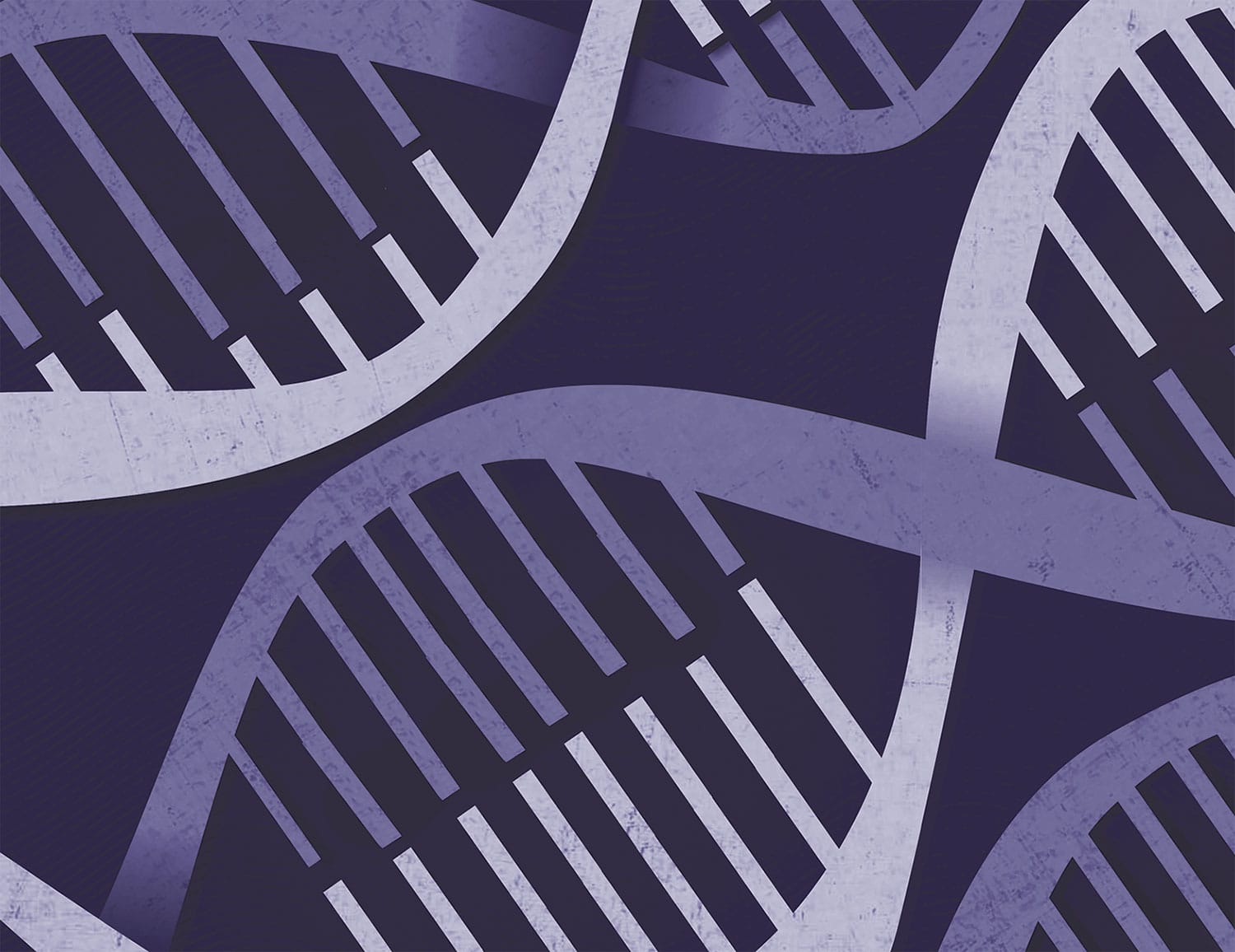SCIENTISTS HAVE SPENT DECADES mapping the tens of thousands of genes encoded in human DNA. They want to understand how genes function and to use this knowledge to treat diseases. CRISPR, a revolutionary gene-editing tool, offers one way to do that. With CRISPR, researchers can “snip” DNA in living human cells and make changes to the genome. Researchers increasingly see CRISPR as a powerful new tool for understanding and treating complex diseases like cancer.
“I think CRISPR is going to have a huge impact on understanding the origins of cancer and how to fight cancer,” says biochemist Ross Wilson at the University of California, Berkeley, whose lab develops ways to make CRISPR and other gene-editing tools more efficient. But CRISPR won’t be an overnight game-changer, Wilson says. He cautions that unraveling the mysteries of cancer’s machinery and vulnerabilities is a complex undertaking, and the gene-editing revolution will unfold slowly on a time-scale of years and decades, rather than weeks and months. “It will probably be a gradual shifting, bringing in more cancers and cancer-associated mutations.”
A CRISPR Clinical Trial
In April 2018, Edward Stadtmauer, an oncologist at the University of Pennsylvania Abramson Cancer Center in Philadelphia, and his colleagues launched a phase I clinical trial to test the safety and toxicity of a treatment developed with CRISPR—the first of its kind in the United States. Three patients were in Stadtmauer’s study: a 67-year-old woman and a 62-year-old woman, both with multiple myeloma, and a 65-year-old man with liposarcoma. All three had previously undergone many rounds of chemotherapy and radiation therapies and had no treatment options left.
The therapy being tested isn’t completely new. Stadtmauer and his team are using CRISPR to mimic immunotherapy treatments already in clinical use. One of those approaches, called CAR-T cell therapy, involves removing a patient’s T cells, genetically tweaking them to recognize and attack cancer cells, and re-infusing them into the body. Modifying T cells in this way can be a lengthy process. In Stadtmauer’s clinical trial, CRISPR is being used in a similar way to modify T cells so they bind to and attack cancer cells. Using CRISPR may make the gene editing process faster and potentially cheaper and more effective.
“Manufacturing modified T cells can take weeks, but a patient may not have weeks to wait,” says Stadtmauer.
CAR-T cell therapy involves adding a receptor to the surface of the T cells that enables them to recognize and attack cancer cells. In Stadtmauer’s trial, researchers first use CRISPR for subtraction. Instead of adding genes to the cells, researchers removed three genes that, they hope, will make the T cells more aggressive (and act like a “warhead,” Stadtmauer says). One of these edits removes PD-1, a gene that produces a protein that acts like a natural braking system in the T cells. After these steps, the researchers use a modified virus to insert a receptor that “tells” the T cell to target an antigen produced by tumor cells.
“Up until now, we’ve been inserting genetic material to engineer the cells to be more active,” says Stadtmauer. “But we think that there are characteristics of the cells that make them less effective. And now, we can remove the genes that inhibit the cells from working.”
The approach of Stadtmauer’s group also exploits the action of another category of immunotherapy drugs called PD-1 inhibitors (and related PD-L1 inhibitors), which in the past few years have added powerful new treatment options for patients. In 2017, a PD-1 inhibitor called Keytruda (pembrolizumab) became the first drug approved by the U.S. Food and Drug Administration (FDA) to treat patients based not on the location of their tumors, but on the tumors’ genetic makeup. But the response rate for immunotherapies like Keytruda varies widely depending on the nature of the patient’s cancer, with at best about a third of patients with advanced cancer responding. Those who do respond to the treatment usually develop resistance.
Stadtmauer’s group presented preliminary findings in December at the annual meeting of the American Society of Hematology in Orlando, Florida, and published their first official data in Science in February. They’re encouraging, Stadtmauer says. Six months after treatment, the patients had experienced minimal side effects and no toxicity. The populations of modified T cells were still measurable in the patients, which means they were proliferating, and some of the liposarcoma patient’s tumors had decreased by as much as 50%. The disease has since worsened in two of the patients, and the third has died.
The phase I trial showed that the treatment was safe, and the findings justified a phase II trial that will launch in 2020. Stadtmauer is cautiously optimistic that the CRISPR-modified T cells will be safe for treating myeloma, chronic leukemia and possibly even solid tumors.
The CRISPR gene-editing system harnesses a defense system that evolved in bacteria.
CRISPR gene editing borrows its mechanism and its name from a natural defense system. When bacteria fight off an invading virus, they retain and catalog a tiny snippet of the virus’s genetic material, like keeping a microbial scrapbook of past battles. These scrapbooked snippets are called clustered regularly interspaced short palindromic repeats, or CRISPRs for short.
If the same type of virus invades again, it’s immediately flagged. The bacteria activate their internal defense, sending an enzyme to disable the virus, with the CRISPR acting as a sort of intracellular navigation system. The enzyme disposes of the viral invader by snipping its DNA, which cripples its ability to launch a successful infection. Biologists first identified CRISPRs in 1987 but didn’t identify them as an immune response to foreign invaders until 2007.
In 2012, biochemists Jennifer Doudna at the University of California, Berkeley, and Emmanuelle Charpentier, then at Umeå University in Sweden, helped lead a research team that demonstrated how CRISPR could be used to guide an enzyme, called Cas9, to a section of DNA and make a precision snip. The method is often called CRISPR-Cas9. (Cas9 stands for CRISPR-associated protein 9.) In 2013, a group led by biochemist Feng Zhang at the Broad Institute in Cambridge, Massachusetts, showed that CRISPR could be used to edit cells from mammals.
Future Opportunities
Experts see myriad ways that CRISPR could advance cancer research. In lab studies on cancer cells, for example, CRISPR could be used to snip, one by one, every gene known to be associated with tumor growth and metastasis. That would in theory show which genes are most important to the cancer’s growth and therefore might make the most powerful targets for new drugs. CRISPR-edited cells could also be used to test new therapies and discover which ones do or do not work at the molecular level. “With an array of these knocked-out genes, you could easily test these cells with tens of thousands of drugs and see how they respond,” says Wilson. “CRISPR has basically launched into hyperspeed the amount of biomedical research we can do in the lab setting.”
There are at least two proposed ways to use CRISPR for new treatments. One is the approach used by Stadtmauer’s team, which involves editing cells that have been removed from the body. Another way is to get CRISPR directly into a tumor, where it will edit the genes of tumor cells. That’s the idea behind a clinical trial designed by molecular geneticist Eric Kmiec and his colleagues.
Their trial is awaiting final approval from the FDA—along with hundreds of other proposed CRISPR-related trials. But Kmiec, who directs the Gene Editing Institute at Christiana Care in Wilmington, Delaware, says he hopes to be ready for a clinical trial in 2021. In previous lab and animal studies, his group showed that when they knocked out a gene called NRF2 in lung cancer cells by using CRISPR, the cells proliferated more slowly and were more vulnerable to chemotherapy. Their goal now is to use CRISPR, injected directly into the tumor, to disable NRF2 in patients with non-small cell lung cancer. They hypothesize that with the gene inactivated, chemotherapy will be more effective and lead to fewer side effects. Kmiec says his group is also looking at experimental approaches to using CRISPR to treat melanoma.
Multiple tools for editing DNA are available.
CRISPR may be the newest and most recognizable tool for making changes to DNA, but it wasn’t the first to use enzymes for gene-snipping. Researchers have been developing ways to treat patients by editing genes since before the turn of the century (though an early misstep in the late 1990s, in which an otherwise healthy patient died, likely set the field back). Here are some of the other tools being explored.
- Transcription activator-like effector nucleases, or TALENs, are enzymes that can be used to make cuts in a strand of DNA more precisely than CRISPR. (More precision means less risk of unintentional cuts.) However, CRISPR is less expensive and can be used to target multiple genes.
- Zinc-finger nucleases, or ZFNs, are another kind of enzyme that can be used to target a small number of base pairs—the rungs in the ladder of DNA—and make a cut. ZFN is also more expensive than CRISPR.
Future Hurdles
Whether or not CRISPR will be useful in treating solid tumors remains an open question. That’s a challenge facing CAR-T cell therapies, too, which currently are most beneficial for blood cancers. “Right now, I’m not convinced that anyone has a super strong approach, even with CRISPR, that’s going to make solid tumors targetable via immuno-oncology approaches,” says Wilson.
Affordability of CRISPR therapies will be another hurdle. “The price tags on gene therapies are enormous,” says bioethicist Jonathan Kimmelman at McGill University in Montreal. “That raises questions about who is going to pay for them, and how we can ensure equitable access.” A single dose of CAR-T cell therapy costs a hospital around $400,000, and that’s just the price of the drug. Some experts predict providers may charge patients more than $1 million for treatment just to break even.
Whether or not people will embrace gene therapy also remains to be seen, says Kmiec. “A lot of patients haven’t heard of it and aren’t following it,” he says. And those who are following it might be frightened. In November 2018, a Chinese researcher named He Jiankui announced that he had used CRISPR to edit a gene associated with HIV in two human embryos, which became two newborn babies. The announcement drew fire from international scientific and medical communities, who criticized He for ethical violations and irresponsible experimentation on people. Among their chief concerns was the fear that the gene edit could result in “off-target” alterations, or unexpected changes in other, unrelated genes. In December 2019, the Chinese government sentenced He to three years in prison.
Controversial experiments like He’s lead to gross misunderstandings about how CRISPR research is conducted, says Kmiec. “It doesn’t help anything, because we have to spend a lot of time saying that it wasn’t ethical and we wouldn’t dream of doing it here.”
For one thing, the Chinese researcher used CRISPR to edit embryonic cells, which means he made changes that could be passed on to future generations. Kmiec and Stadtmauer point out that they are altering cells that won’t be inherited by offspring. That doesn’t mean CRISPR-based therapies have been unequivocally proven to be safe. There remains a risk that gene editing will produce unexpected outcomes. “As we move into an era where we’re using gene-editing techniques to treat cancer, I wouldn’t be surprised if there are safety issues that crop up that really weren’t anticipated,” says Kimmelman.
The future of CRISPR-based cancer treatments will be guided by how researchers respond to these challenges, how patients respond to the first clinical trials, and how well people understand the technology itself. But the promise is too enormous not to pursue, says Wilson.
One of the most enticing possibilities he sees on the horizon is that of “off-the-shelf” immunotherapies.
Healthy people could donate T cells, which researchers could edit using CRISPR so they would attack cancer cells and not be rejected by another person’s body. Then, hospitals could maintain stores of these fighting cells and transfuse them into patients who would benefit.
“The technology used to make these kinds of engineered cells to fight cancer will only be accelerated,” says Wilson. “It would be transformative. It’s something that really wouldn’t be feasible with other genome editing technology, but it’s something that CRISPR makes feasible.”
Cancer Today magazine is free to cancer patients, survivors and caregivers who live in the U.S. Subscribe here to receive four issues per year.





